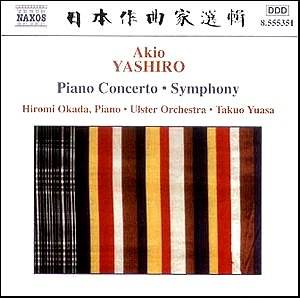Naxos’s
‘Japanese Classics’ series continues apace, and what unknown treasures
are surfacing. These composers are practically unplayed in the
West and I feel strongly that we are missing out. Anyway before
I start the review, three cheers to all concerned for presenting
this music so well, in fine recordings and so cheaply.
The
Ulster Orchestra, coming to this music completely afresh but under
the Japanese conductor Takuo Yuasa, who is making a reputation
internationally, they respond wonderfully and are in fine form
For
the reader to grasp the language of this composer and to know
what to expect if you are to splash out the £5 required we should
have a brief look at Yasiro’s biography.
He
was born of a well-to-do family in Tokyo, his father being a leading
historian of European Fine Arts. His mother was a pianist. His
first teachers were all local but mostly steeped in Classical
Western music. They included Sabuto Moroi who had studied in Berlin
and who greatly admired Beethoven. " Moroi believed that
the organic and strict development of a motif was in all composition."
(booklet notes by Morihude Katayama). His next teacher Qunihaco
Hashimoto introduced him to Debussy, Ravel and Stravinsky. Yashiro’s
school, Gyoset High, was run "by French Catholic monks …
and he was trained in the French language". He later moved
in circles which included contemporary Japanese composers who
had studied with Tcherepnin. He went off to Paris to sit at the
knees of Nadia Boulanger and Olivier Messiaen.
It
was Yashiro’s belief that he should not be too prolific. His emphasis
was on the highly fastidious; another French trait. Each work
"should be perfect"- an intriguing prospect.
Consequently
the only survivals from his pen are: a sonata for two flutes,
a piano sonata, and a string quartet written whilst he was a Parisian
student. There is also a cello concerto in addition to the works
recorded here. You can also find some film music written during
his twenties.
It
should not be surprising to find in the two works represented
here, influences of all of these philosophies and figures. Bartók
appears at the beginning of the Concerto. Messiaen features in
its second movement (the slow music from Turangalila).
There is more Messiaen in the Adagio of the Symphony’s first movement.
Debussy and Ravel figure also in the use of impressionist harmonies
and orchestration. This is especially prominent in the slower
music. Traditional Japanese music can be heard in the percussion
writing of the Lento of the Symphony and in the rhythm of its
Scherzo which uses a 6/8+ 2/8+6/8 pattern.
Having
said all that, his the voice is uniquely his own and in my view
it is quite fascinating, beautiful and exotic. One can only regret
that Yashiro’s early death at the age of 47 put an end to what
was still a burgeoning compositional life. If I have a criticism
of the symphony it is that there is a predominance of slow music.
The Scherzo is less than four minutes and the last movement is
only Allegro energico for just over half of its nine minute course.
The work lasts almost thirty-three minutes.
These
then are substantial works which will, I am sure, afford great
pleasure and reward repeated playings. As a party game, play your
friends the second movement of the Piano Concerto with its three
bar repetition of the note C forty-one times or the rolling opening
of the symphony. See which composers they come up with. I found
it quite intriguingly revealing.
Gary
Higginson
